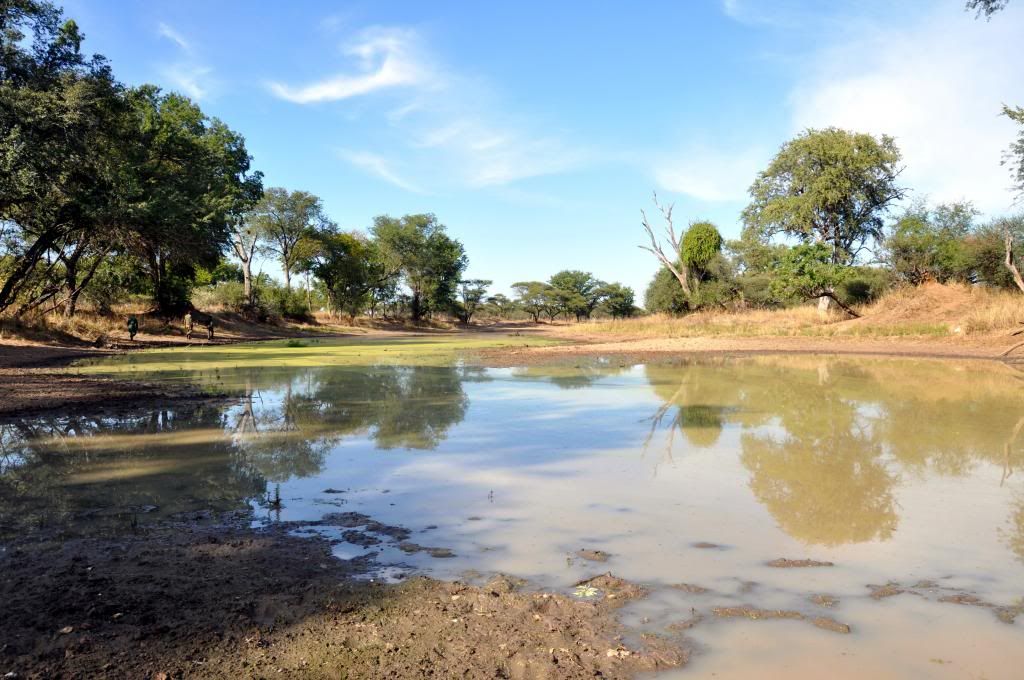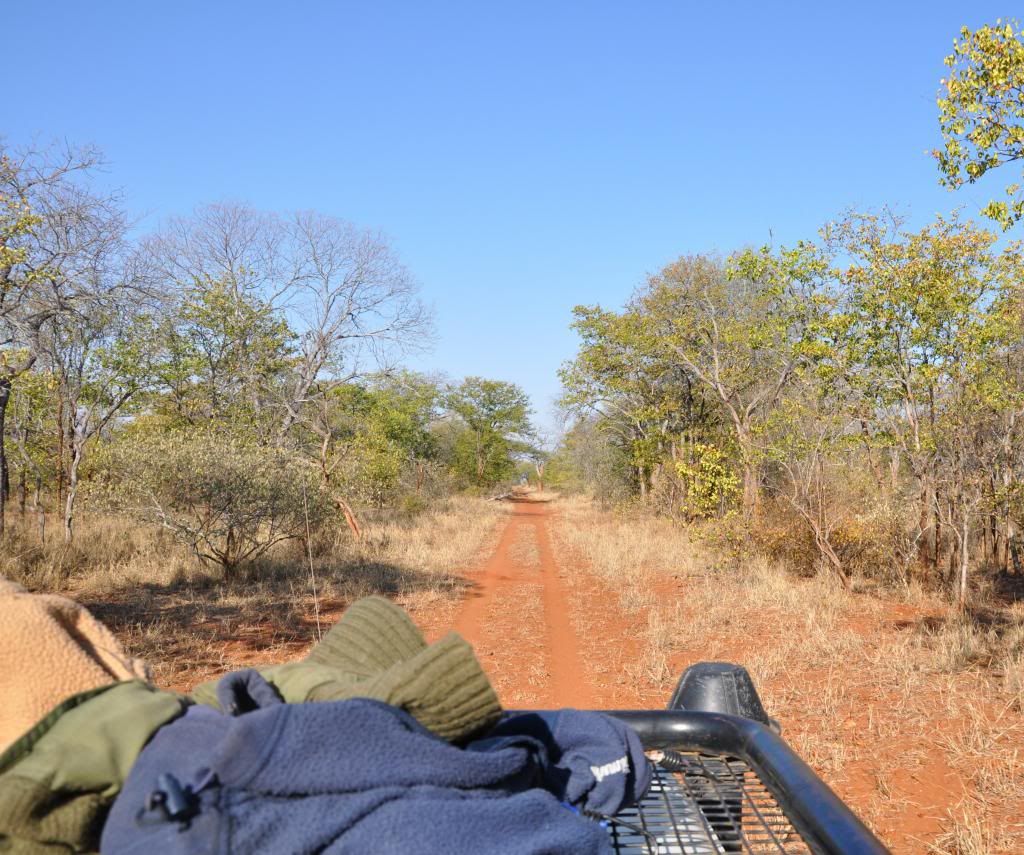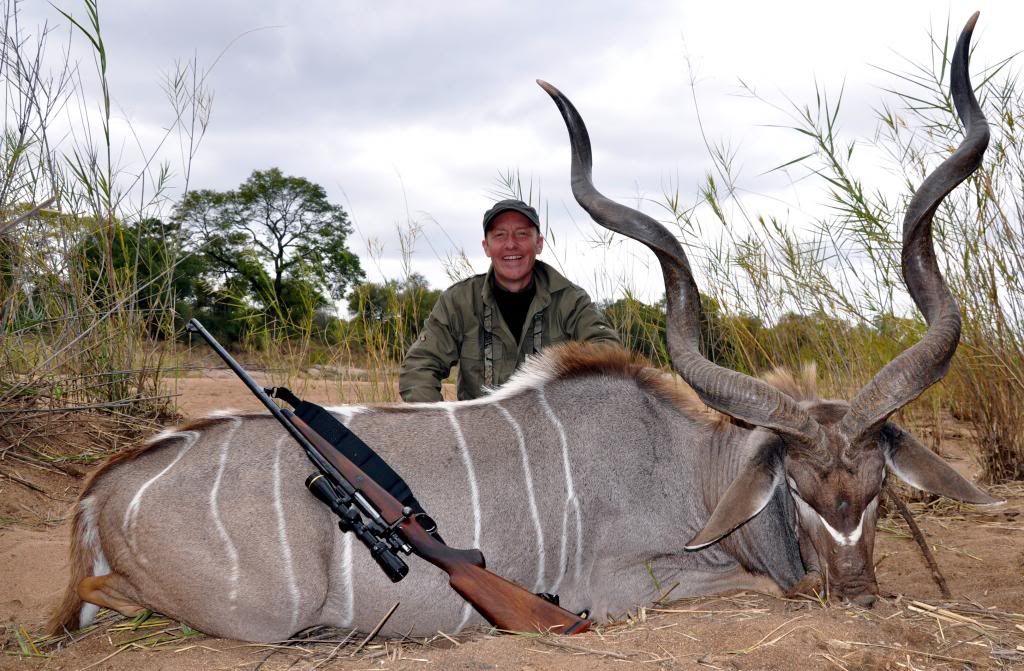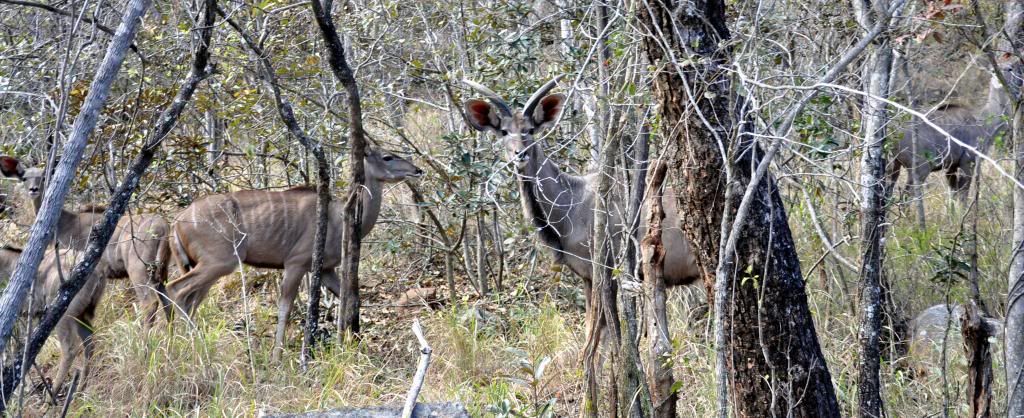

 The Accurate Reloading Forums
The Accurate Reloading Forums  THE ACCURATE RELOADING.COM FORUMS
THE ACCURATE RELOADING.COM FORUMS  Hunting
Hunting  African Big Game Hunting
African Big Game Hunting  Gray Ghosts of the Bubye River
Gray Ghosts of the Bubye RiverGo  | New  | Find  | Notify  | Tools  | Reply  |  |
| One of Us |
Gray Ghosts of the Bubye River Kevin Thomas© When we’d first glimpsed him in the riverine thickets high up on the Bubye River bank opposite us, the kudu bull looked a good trophy, maybe 54”. Nowadays in our era of shortened safaris, he’d certainly be considered a shooter. It was early June and he was in the company of four females, the rut still ongoing. We’d sat watching as they came quietly down a game trail on the opposite bank, periodically lingering, soft eyes watchful, alert, parabolic ears constantly moving as they searched for the slightest sound that’d indicate danger. As per normal, the bull trailed the single line of females. After a final nibble on some convenient browse the group suddenly moved more purposefully out onto the sand and proceeded to cross the riverbed. When they got about midway they stopped and clustered together, the bull showing interest in the one female, and it was then that we glassed him more carefully – still undecided whether to take him or not – above us a querulous Gray Go-away-bird clung to a wind-whipped branch, ‘gaa-waaaaayy’ - missing nothing that’s going on in their vicinity, they can irritate during a stalk. Suddenly, movement on the opposite riverbank again caught our attention when out of the deep shadow stepped a true monarch. It was the first time I’d seen him although his majestic carriage and sheer trophy quality would forever after be etched into my mind, as I quickly recalled that over the years I’ve had three clients shoot 60” kudu along this magnificent river, and the one across from us was well inside that category. During the previous season too, a 63 inch kudu had been shot not far from where we sat. It was self evident the stately interloper we now observed probably belonged to the same gene pool. He proudly carried high scoring deep curls, wide horns, thickness, length, and easily discernable outward pointing ivory tips – indeed a trophy connoisseurs dream. Walking boldly out to join the group, and after a short ritualistic joust, he saw the attendant male off, and then concentrated on the females. Both bulls had heavy thick necks, consistent with the rut. As we watched the noble old bull, his horns dwarfing those of the attendant bull, he suddenly lost interest and moved away, stopping periodically and staring downstream as if lost in kudu thoughts of his younger days. We quickly slid down the bank keeping ourselves hidden from view in the reeds, and once on the riverbed snaked our way towards a lone tree with dry debris from passed floods piled against it. As soon as we reached it I opened the shooting sticks and whispered to my client to take the shot. The bull was about 185m out and broadside on, and then just as I was expecting the shot, he swung round and slowly made his way back towards the far bank. He was moving very slowly and I again whispered to the client to attempt a shot before the bull reached the bank. However, we’d already had a few animals wounded and he seemed reluctant to shoot, and then as we waited and watched, the bull reached the bank and lingered on the riverbed in the deep shadow cast by the trees. It was then that Jose decided to take the shot – all of 300m by that stage, and he shot a bit low, the .338 Win Mag 210gr kicking up brown dust on the riverbank well below the kudu’s belly line. With one bound, he was up the bank and almost immediately swallowed by greenery, a gray streak, with his head up, and carrying his wide horns lying over his rump. In the aftermath of the failed gunning exercise we walked across to where he’d been standing, and cast around. We also went up the bank slowly following the gouged out hoof prints of a heavy antelope in a hurry, although as we’d expected there was no blood. We followed the tracks out of the riverine shadow and into the hot heat shimmering stillness of the scrub mopane, not for very long though because it was an exercise in futility, that particular kudu had reached old age through wisdom. Over the remaining two days of the safari we continued to hunt hard for a good kudu, and even had another brief glimpse of the missed monarch while he made off at speed, having heard the rig’s diesel engine grumbling as we crossed a dry tributary to the Bubye. On another occasion in the scrub shrouded shale ridges far to the west of the Bubye River, a bull in the high fifties held still, facing away from us and ignorant of our presence. His thick neck providing a prime target for the 60m shot, however, Jose suddenly drew back from the scope and lifted his rifle off the sticks. His overriding fear of another wounded and possibly lost animal had got to him, and so the safari ended, and although he went away happy, there wasn’t a kudu head amongst his other trophies. Within two days of his departure I was back in the area, in a camp further north and away from the river. This didn’t deter me too much because our hunting block shared a common boundary by way of a dirt road with the block where we’d first seen the stand-out kudu. Animals aren’t confined to blocks by roads and tracks and I knew the big bull was probably wandering between the two blocks, although given his age he seemed to favor the riverine fringes and pools along the Bubye. With this in mind I decided Jamie, his son Josh, and I would concentrate on the riverine more than in the dry scrub to the west. With a buffalo being the priority trophy, we worked on getting that out of the way as quickly as possible, and we lucked out on the second day and in the days following cleaned up on other plains game. Each day though, we also looked at kudu, a good bull was seen once or twice not far from camp although he always faded from sight, as kudu so often do, before you can put the bullet in. We also drove inland, to the west and hunted the flat dry scrubland, and low shale ridges where once or twice we saw kudu, albeit brief sightings as they hurriedly crossed the track through the heat mirages shimmering and dancing in the far distance ahead of us. Those we stalked weren’t what I was looking for, and on one occasion, after having obtained clearance from Blondie Leatham we went north to Ripple Creek, and hunted another block which at the time was free of hunting clients and it also had the Bubye River meandering through it. Whenever we hunted west of the river, and if we got onto high ground the ribbon of green riverine running north to south, and way to our east seemingly always beckoned us back towards the river, and that elusive gray ghost we so determinedly sought. Once, and only about 1km from camp, we stalked a good kudu but he screened himself from us in a stand of tall thin mopane and other winter dry sapling types, dry hanging leaves, and close standing limbs, all in grays and browns, and like the kudu, made it almost impossible for us to see him. When we eventually did we couldn’t risk a shot because of deflection and possible wounding, so for a few seconds time stood still – and then, tiring of our whispering, he was gone, with a clatter of pebbles and not much else to indicate he’d ever been there in the first place. On Jamie’s 40th birthday we hunted from sunrise to sunset for a kudu, and although we saw kudu, we didn’t shoot one, and each time we hunted the area where I thought we might cross paths with the missed stand-out bull of my previous safari, we drew a blank. Finally, on the penultimate day of the safari we woke to blustery overcast weather and as per the previous kudu seeking days, our early morning hunt was unproductive. At 10hr00 we drove south and then east along the track separating the two hunting blocks. Where we finally hit the Bubye River and turned north was only about 500m from where I’d last seen the stand-out bull. Once more however, my hopes that he’d suddenly appear didn’t bear fruit, and by then, we’d decided to shoot any good, fully mature kudu bull over about 52”. There is a management limit on trophy size on the conservancy, with no kudu under 50” allowed to be shot. Not much further north, we suddenly saw a group of kudu cows leap effortlessly from left to right across the cut line we were following. They disappeared into the riverine thickets leading down onto the riverbed. Although we hadn’t yet seen him, we were sure there was a bull present, and then, as we quickly alighted from the rig, grabbing the shooting sticks and rifle, a tracker pointed and whispered “Khangela!” (“Look!”). Following the direction in which he was pointing, we saw the four cows ahead of us, standing in the centre of the riverbed. Jamie and I took off as quietly as possible, quickly weaving our way through the dense riverine, until we were about 120m from the group of nervous kudu – and it was only then that we saw the bull. He was standing in front of the cows and slightly to their left, one quick look with the binoculars told me he was a keeper, so I quickly flicked the sticks open whilst mouthing the words “Shoot him!” Jamie came up onto them in one fluid motion, and still the kudu hadn’t seen us – however, they were extremely tense, standing sculpture like, looking, and listening. The bull was perfectly presented, broadside on and as the shot reverberated up and down the riverbed, he lurched forward, hunched, and then ran blindly back towards the bank we were standing on, the cows took off as one in the opposite direction across the riverbed. As we moved quietly along the bank looking down into the reeds and open patches Jamie suddenly shouted, “There he is – he’s down!” – As indeed he was, the .375 H&H Rhino 380gr bullet having destroyed his heart. We stood in silence admiring his heavy horns and ivory tips, Jamie was ecstatic and when eventually back at the skinning shed, I ran a tape along the heavy horns and they went a respectable 55”.  Consistent with the rut the bulls were heavy necked.  Over the years I’ve had three clients shoot 60” kudu along this magnificent river.  We also drove far inland to the west and hunted the dry scrublands.  We regularly checked inland waterholes for kudu bull spoor.  An ecstatic Jamie Cox with his 55” kudu bull.  The cryptic colouration of kudu makes them exceeding difficult to see in thick cover, and their ability to fade from sight within seconds deservedly earns them the sobriquet ‘gray ghosts’ amongst sport hunters. Kevin Thomas Safaris Zimbabwe - Eastern Cape E-mail: ktsenquiries@mweb.co.za Website: www.ktsafaris.co.za | ||
|
| One of Us |
That's a lovely kudu. I tend to lke those with well-spread horntips. -- Promise me, when I die, don't let my wife sell my guns for what I told I her I paid for them. | |||
|
| One of Us |
Great read and nice pics DRSS Searcy 470 NE | |||
|
| One of Us |
Congratulations, nice bull. Life member NRA formally scrappy | |||
|
| One of Us |
Great story. Thanks for sharing. Nice bull. Bruce | |||
|
| One of Us |
Excellent kudu, congrats! I hunted the SVC & BVC the last 2 years. We saw 1 kudu in the BVC, which my wife shot. This past summer in SVC we saw multiple huge kudu daily. Granted there are many variables, not the least of which are your particular camp/outfitter and the area's lion density. | |||
|
| Powered by Social Strata |
| Please Wait. Your request is being processed... |
|
 The Accurate Reloading Forums
The Accurate Reloading Forums  THE ACCURATE RELOADING.COM FORUMS
THE ACCURATE RELOADING.COM FORUMS  Hunting
Hunting  African Big Game Hunting
African Big Game Hunting  Gray Ghosts of the Bubye River
Gray Ghosts of the Bubye River

Visit our on-line store for AR Memorabilia

